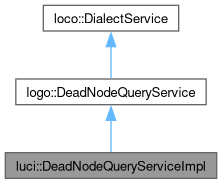Loading...
Searching...
No Matches
luci::DeadNodeQueryServiceImpl Struct Referencefinal
#include <DeadNodeQueryService.h>
Collaboration diagram for luci::DeadNodeQueryServiceImpl:

Public Member Functions | |
| bool | isDeadNode (loco::Node *node) final |
| Check if the node is dead node. | |
 Public Member Functions inherited from logo::DeadNodeQueryService Public Member Functions inherited from logo::DeadNodeQueryService | |
| virtual | ~DeadNodeQueryService ()=default |
 Public Member Functions inherited from loco::DialectService Public Member Functions inherited from loco::DialectService | |
| virtual | ~DialectService ()=default |
Detailed Description
Definition at line 27 of file DeadNodeQueryService.h.
Member Function Documentation
◆ isDeadNode()
|
finalvirtual |
Check if the node is dead node.
Implements logo::DeadNodeQueryService.
Definition at line 39 of file DeadNodeQueryService.cpp.
40{
44
48
50 return false;
51 // input and output nodes are not dead node even if it is not active.
53 return false;
54
55 // if node is one of virtual mulitple outputs, we need to ask the real node
57 {
58 VirtualOutputDetector d;
60 {
61 assert(node->arity() == 1);
64 return false;
66 return false;
67 }
68 }
69
70 return true;
71}
std::set< loco::Node * > active_nodes(const std::vector< loco::Node * > &roots)
Enumerate all the nodes required to compute "roots".
Definition Algorithm.cpp:112
Definition CircleNodeDecl.h:42
References loco::active_nodes(), loco::Node::arg(), loco::Node::arity(), loco::Node::graph(), loco::input_nodes(), luci::must_cast(), and loco::output_nodes().
The documentation for this struct was generated from the following files:
- compiler/luci/lang/include/luci/IR/DeadNodeQueryService.h
- compiler/luci/lang/src/DeadNodeQueryService.cpp